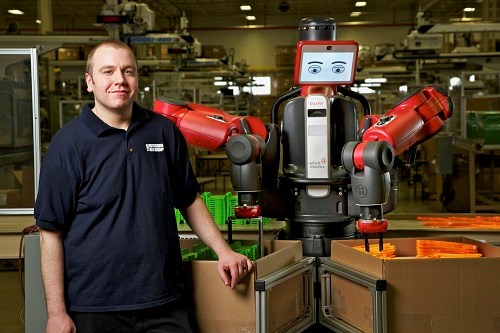Safety Guidance Coming for ‘Collaborative’ Robots
Safety standards coming for robots designed to work alongside humans.
So-called “collaborative” robots are designed to work safely alongside humans without requiring isolation behind a safety cage. Perhaps the best-known example is the Baxter robot from Rethink Robotics, Boston. For safety, it incorporates 360° sonar and front-facing vision system to detect human presence and perform its tasks. It can “see” in 3D, sensing height and distance. And its “servo-elastic” control prevents harmful collisions: If one of its two arms meets resistance force of less than 1 lb, it will stop, and then continue on its path once the resistance is removed (for more details, see Nov. ’13 Close Up).

The Baxter robot at the Rodon Group.
In order to ensure safe operation of all such devices, the Robotic Industries Association (RIA), Ann Arbor, Mich., is working with the International Organization for Standardization (ISO) committee for Industrial Robot Safety in developing Technical Specification TS 15066 for guidance on safe deployment of collaborative robots. (It will expand on the brief discussion in ANSI/RIA R15.06-2012, Parts 1 & 2.) A key provision of TS 15066 will be threshold power and force values and guidance for situations where contact between humans and collaborative robots can occur. Still a work in progress, the final specification is expected to be published late this year or in early 2015. In the meantime, The German machinery manufacturers’ organization VDMA has prepared a position paper, “Safety in Human-Robot Collaboration,” that summarizes the relevant ISO standards and other related guidance on collaborative robots. The PDF is available here.
Related Content
-
Real-Time Production Monitoring as Automation
As an injection molder, Windmill Plastics sought an economical production monitoring system that could help it keep tabs on its shop floor. It’s now selling the “very focused” digital supervisor it created, automating many formerly manual tasks.
-
50 Years of Headlines … Almost
I was lucky to get an early look at many of the past half-century’s exciting developments in plastics. Here’s a selection.
-
Automation Evolution: From Robots to Work Cells, Solo Devices to Integrated Systems
Injection molding automation has progressed from devices to systems, from simplicity to more complex capabilities. The author traces this development through various levels of automation – all still available choices today – and analyzes the costs and capabilities for each level.













